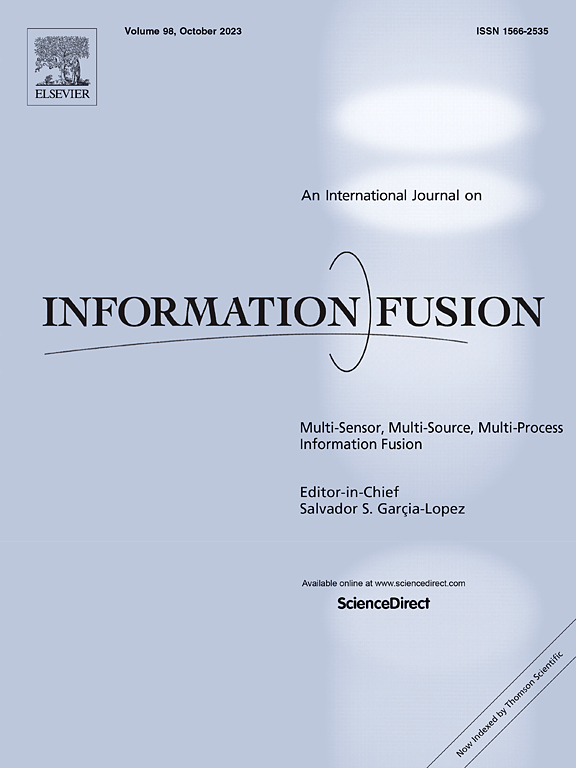Enhancing skin cancer detection through category representation and fusion of pre-trained models
IF 15.5
1区 计算机科学
Q1 COMPUTER SCIENCE, ARTIFICIAL INTELLIGENCE
引用次数: 0
Abstract
The use of pre-trained models in medical image classification has gained significant attention due to their ability to handle complex datasets and improve accuracy. However, challenges such as domain-specific customization, interpretability, and computational efficiency remain critical, especially in high-stakes applications such as skin cancer detection. In this paper, we introduce a novel interpretability-assisted fine-tuning framework that leverages category representation to enhance both model accuracy and transparency.
Using the widely known HAM10000 dataset, which includes seven imbalanced categories of skin cancer, we demonstrate that our method improves the classification accuracy by 2.6% compared to standard pre-trained models. In addition to precision, we also achieve significant improvements in interpretability, with our category representation framework providing more understandable insights into the model’s decision-making process. Key metrics, such as precision and recall, show enhanced performance, particularly for underrepresented skin cancer types such as Melanocytic Nevi (F1 score of 0.94) and Actinic Keratosis (F1 score of 0.66).
Furthermore, the prediction accuracy of the proposed model of the top-3 reaches 98. 21%, which is highly significant for medical decision making. This observation in interpretability underscores the value of top- predictions, especially in challenging cases, to support more informed and accurate decisions. The proposed fusion framework not only enhances predictive accuracy, but also offers an interpretable model output that can assist clinicians in making informed decisions. This makes our approach particularly relevant in medical applications, where both accuracy and transparency are crucial. Our results highlight the potential of fusing pretrained models with category representation techniques to bridge the gap between performance and interpretability in AI-driven healthcare solutions.
通过类别表示和预训练模型融合增强皮肤癌检测
在医学图像分类中使用预训练模型由于其处理复杂数据集和提高准确性的能力而受到了极大的关注。然而,领域特定的定制、可解释性和计算效率等挑战仍然至关重要,特别是在高风险的应用程序中,如皮肤癌检测。在本文中,我们引入了一个新的可解释性辅助微调框架,该框架利用类别表示来提高模型的准确性和透明度。使用广为人知的HAM10000数据集,其中包括七个不平衡的皮肤癌类别,我们证明了我们的方法与标准预训练模型相比,将分类精度提高了2.6%。除了精度之外,我们还在可解释性方面取得了重大改进,我们的类别表示框架为模型的决策过程提供了更容易理解的见解。关键指标,如准确性和召回率,显示出增强的性能,特别是对于未被充分代表的皮肤癌类型,如黑素细胞痣(F1得分为0.94)和光化性角化病(F1得分为0.66)。此外,该模型对前3位的预测精度达到98。21%,这对医疗决策非常重要。这种可解释性的观察结果强调了top-n预测的价值,特别是在具有挑战性的案例中,它可以支持更明智、更准确的决策。所提出的融合框架不仅提高了预测的准确性,而且还提供了一个可解释的模型输出,可以帮助临床医生做出明智的决策。这使得我们的方法在准确性和透明度都至关重要的医疗应用中特别相关。我们的研究结果强调了将预训练模型与类别表示技术融合在一起的潜力,以弥合人工智能驱动的医疗保健解决方案中性能和可解释性之间的差距。
本文章由计算机程序翻译,如有差异,请以英文原文为准。
求助全文
约1分钟内获得全文
求助全文
来源期刊

Information Fusion
工程技术-计算机:理论方法
CiteScore
33.20
自引率
4.30%
发文量
161
审稿时长
7.9 months
期刊介绍:
Information Fusion serves as a central platform for showcasing advancements in multi-sensor, multi-source, multi-process information fusion, fostering collaboration among diverse disciplines driving its progress. It is the leading outlet for sharing research and development in this field, focusing on architectures, algorithms, and applications. Papers dealing with fundamental theoretical analyses as well as those demonstrating their application to real-world problems will be welcome.
 求助内容:
求助内容: 应助结果提醒方式:
应助结果提醒方式:


